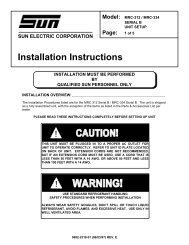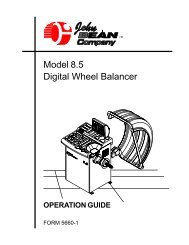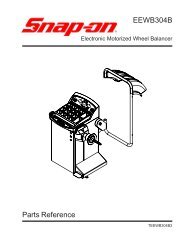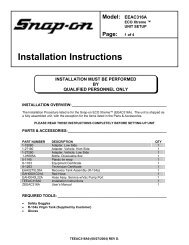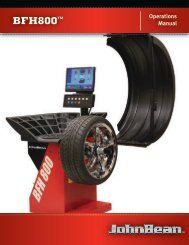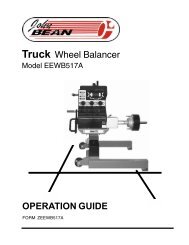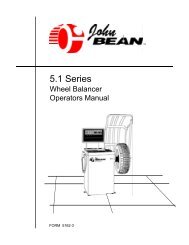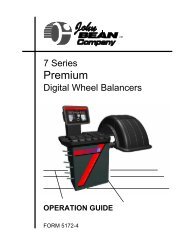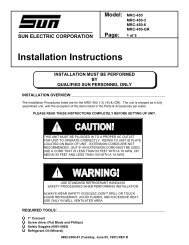here - Snap-on Equipment
here - Snap-on Equipment
here - Snap-on Equipment
Create successful ePaper yourself
Turn your PDF publications into a flip-book with our unique Google optimized e-Paper software.
Safety Informati<strong>on</strong><br />
The signal word indicates the level of the hazard in a situati<strong>on</strong>.<br />
• DANGER indicates an imminently hazardous situati<strong>on</strong> which,<br />
if not avoided, will result in death or serious injury to the<br />
operator or bystanders.<br />
• WARNING indicates a potentially hazardous situati<strong>on</strong> which,<br />
if not avoided, could result in death or serious injury to the<br />
operator or bystanders.<br />
• CAUTION indicates a potentially hazardous situati<strong>on</strong> which, if<br />
not avoided, may result in moderate or minor injury to the<br />
operator or bystanders.<br />
• IMPORTANT indicates a situati<strong>on</strong> which, if not avoided, may<br />
result in damage to the test equipment or vehicle.<br />
Safety messages in this secti<strong>on</strong> c<strong>on</strong>tain three different type<br />
styles.<br />
• Normal type states the hazard.<br />
• Bold type states how to avoid the hazard.<br />
• Italic type states the possible c<strong>on</strong>sequences of not avoiding<br />
the hazard.<br />
An ic<strong>on</strong>, when present, gives a graphical descripti<strong>on</strong> of the<br />
potential hazard.<br />
IMPORTANT SAFETY INSTRUCTIONS<br />
Power<br />
Risk of a lack of oxygen.<br />
— Vehicle exhaust gases c<strong>on</strong>tain carb<strong>on</strong> m<strong>on</strong>oxide.<br />
— Refrigerant gas can displace air in work area.<br />
• Use your KOOL KARE unit in locati<strong>on</strong>s with<br />
mechanical ventilati<strong>on</strong> providing at least four air<br />
changes per hour.<br />
Impairment of breathing can cause injury.<br />
Risk of electric shock and fire.<br />
• To avoid electric shock the power cord must be<br />
c<strong>on</strong>nected to a properly grounded A.C. outlet.<br />
• Do not remove or bypass the grounding pin.<br />
• Use the proper A.C. outlet for the unit to operate<br />
correctly. See the ID plate <strong>on</strong> the back of the unit.<br />
• Extensi<strong>on</strong> cords are not recommended. If an<br />
extensi<strong>on</strong> cord must be used, use:<br />
— 16 AWG for cords up to 50', and<br />
— 14 AWG for cords greater than 50' but less<br />
than 100'.<br />
• Do not use <strong>on</strong> wet surfaces or expose to rain<br />
• Use <strong>on</strong>ly fuses with the rating specified near the<br />
fuse holder.<br />
Electric shock and fire can cause injury.<br />
II



